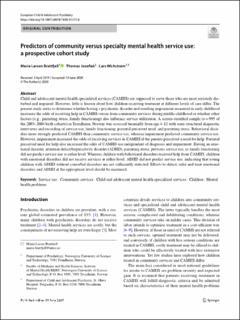| dc.contributor.author | Brattfjell, Maria Larsen | |
| dc.contributor.author | Jozefiak, Thomas | |
| dc.contributor.author | Wichstrøm, Lars | |
| dc.date.accessioned | 2021-05-07T06:49:47Z | |
| dc.date.available | 2021-05-07T06:49:47Z | |
| dc.date.created | 2021-02-01T17:57:53Z | |
| dc.date.issued | 2020 | |
| dc.identifier.issn | 1018-8827 | |
| dc.identifier.uri | https://hdl.handle.net/11250/2754040 | |
| dc.description.abstract | Child and adolescent mental health specialized services (CAMHS) are supposed to serve those who are most seriously disturbed and impaired. However, little is known about how children receiving treatment at different levels of care differ. The present study seeks to determine whether having a psychiatric disorder and resulting impairment measured in early childhood increases the odds of receiving help in CAMHS versus from community services during middle childhood or whether other factors (e.g., parenting stress, family functioning) also influence service utilization. A screen-stratified sample (n = 995 of the 2003-2004 birth cohorts) in Trondheim, Norway was assessed biennially from age 4-12 with semi-structured diagnostic interviews and recording of service use, family functioning, parental perceived need, and parenting stress. Behavioral disorders more strongly predicted CAMHS than community service use, whereas impairment predicted community service use. However, impairment increased the odds of receiving services in CAMHS if the parents perceived a need for help. Parental perceived need for help also increased the odds of CAMHS use independent of diagnosis and impairment. Having an emotional disorder, attention deficit/hyperactivity disorder (ADHD), parenting stress, previous service use, or family functioning did not predict service use at either level. Whereas children with behavioral disorders received help from CAMHS, children with emotional disorders did not receive services at either level. ADHD did not predict service use, indicating that young children with ADHD without comorbid disorders are not sufficiently detected. Efforts to detect, refer and treat emotional disorders and ADHD at the appropriate level should be increased. | en_US |
| dc.language.iso | eng | en_US |
| dc.publisher | Springer | en_US |
| dc.rights | Navngivelse 4.0 Internasjonal | * |
| dc.rights.uri | http://creativecommons.org/licenses/by/4.0/deed.no | * |
| dc.title | Predictors of community versus specialty mental health service use: a prospective cohort study | en_US |
| dc.type | Peer reviewed | en_US |
| dc.type | Journal article | en_US |
| dc.description.version | publishedVersion | en_US |
| dc.source.journal | European Child and Adolescent Psychiatry | en_US |
| dc.identifier.doi | 10.1007/s00787-020-01575-8 | |
| dc.identifier.cristin | 1885452 | |
| dc.relation.project | Norges forskningsråd: ES611813 | en_US |
| dc.relation.project | Samarbeidsorganet mellom Helse Midt-Norge og NTNU: xxxxx | en_US |
| dc.description.localcode | © The Authors 2020. Open AccessThis article is licensed under a Creative Commons Attribution 4.0 International License, which permits use, sharing, adapta-tion, distribution and reproduction in any medium or format, as long as you give appropriate credit to the original author(s) and the source, provide a link to the Creative Commons licence, and indicate if changes were made. The images or other third party material in this article are included in the article’s Creative Commons licence, unless indicated otherwise in a credit line to the material. If material is not included in the article’s Creative Commons licence and your intended use is not permitted by statutory regulation or exceeds the permitted use, you will need to obtain permission directly from the copyright holder. To view a copy of this licence, visit http://creativecommons.org/licenses/by/4.0/. | en_US |
| cristin.ispublished | true | |
| cristin.fulltext | original | |
| cristin.qualitycode | 2 | |

